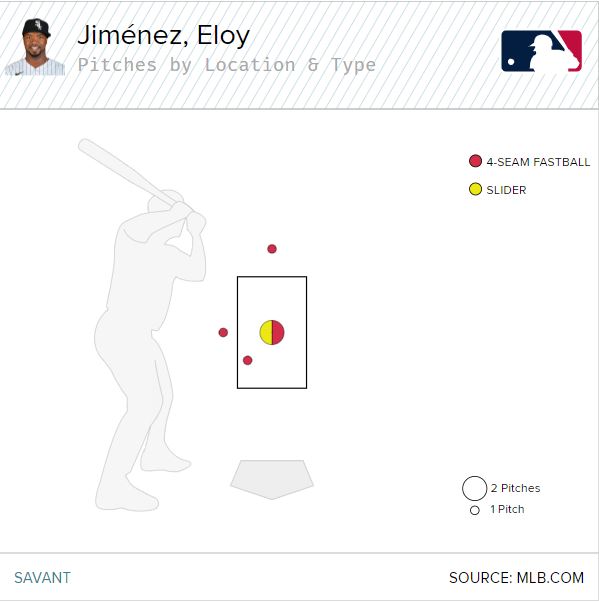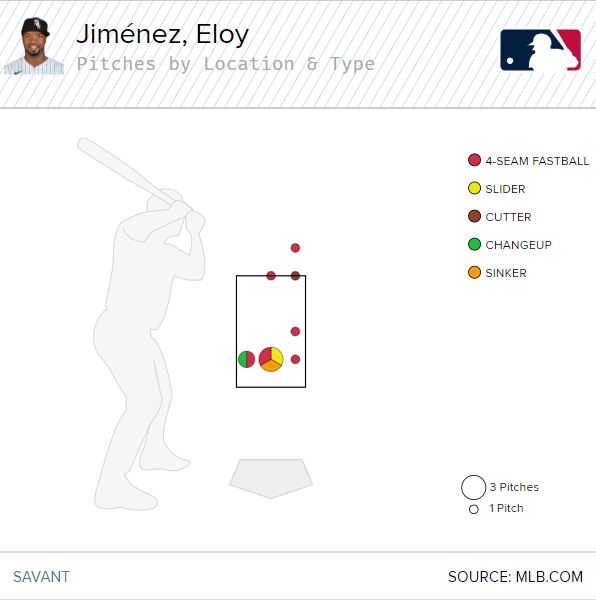Eloy Jiménez Is Strong
If you want power, pull the ball in the air. It’s a truism because it’s true. On pulled air balls (line drives and fly balls), batters hit .558 with a 1.285 slugging percentage in 2020. When they went to the opposite field, they hit .297 with a .522 slugging percentage. It isn’t rocket science; pulling means power, and power means production.
Want another way of putting it? Those opposite-field air balls were hit with an average 86.8 mph exit velocity. Only 26.6% of them were hit at 95 mph or harder. When batters pulled the ball, they did far better — they checked in at 94 mph on average and 54.7% were 95 mph or higher. You don’t need any fancy statistics to tell you how much better that is.
Even if you take for granted that a batter hit the ball hard, it’s still better to pull the ball. When batters barreled up balls to the pull side, they slugged 3.283. A barrel is high-value by nature, but a slugging percentage of 3.283 is still hard to fathom. Those balls were hit a comical 105.6 mph on average, and hitters posted a 1.679 wOBA on them — again, you don’t need me to tell you that’s good. It’s good!
Barrel a ball to the opposite field, and the results aren’t bad, per se — after all, a barrel is a high-value hit by definition. Compared to the gaudy results on pulled barrels, though, it’s a disappointment; a 2.588 slugging percentage on 102.4 mph average exit velocity, good for a 1.347 wOBA. Good, but not as good as it could be; pulling the ball creates more juice.
Got that all straight? It’s harder to barrel the ball up when you hit it to the opposite field. Even when you do, it’s hard to get as much production out of it as you do to the pull side. Great, we have that covered. Now, meet Eloy Jiménez:
That’s an opposite-field barrel, one of 10 such batted balls Jiménez hit last year. That led baseball, and it wasn’t some volume-based fluke; 21.3% of the opposite-field balls that he hit, period, were barreled. That’s almost double his rate on pulled balls (11.9%). Did Eloy figure out how to beat the sheer inevitability of pull production being better?
I’ll save you the suspense — he didn’t. Let’s delve a little deeper into his batted balls, though, and see if we can’t discover something. First, take a look at the pitches he barreled to the pull side:

Nothing too surprising here. It’s mostly fastballs, and mostly middle-in; that’s the kind of pitch you can turn on, and Jiménez is certainly capable of doing that. On the other hand, his opposite-field barrels are more diverse:

Here’s our first clue. When Jiménez barrels something to the opposite field, he more frequently does it with pitches away. That’s true of the league as a whole; the average pulled barrel was thrown about 1.5 inches closer to the batter than the dead middle of the plate. In other words, middle-in pitches are easier to pull. Oppo barrels? The pitches that produced them were, on average, three inches further away from the batter than dead middle.
It’s just physics: when the ball is on the outer half of the plate, it’s harder to get the bat around and pull it. If you want to hit the ball with authority to the opposite field, you’ll want to swing at outside pitches.
Clearly, then, he must swing at an outrageous amount of outside pitches. There’s just one problem with this theory: he doesn’t. When a pitcher throws something in the outer third of the strike zone, he swings 70.8% of the time. That’s higher than the major league average of 61.2% — but it’s meaningfully lower than his swing rate on the inner third, which checks in at 78.9%.
Put another way, there’s nothing unique about the zones he targets. Why didn’t he rack up more pulled barrels? It’s a matter of volume. He saw 144 pitches on the outer third of the strike zone, as compared to 76 on the inner third. That mismatch was the sixth-highest in the game last year, and the top 10 is dotted with sluggers. Why is Jiménez making contact with so many pitches away? Because pitchers are throwing the ball there, and he’s going with the flow.
When you look at it this way, his opposite-field power isn’t some weird exception to the way baseball works. He isn’t taking pitches that other hitters would pull and inside-outing them into right field. He’s merely working with what the pitcher gives him, following the path of least resistance to a pile of smoked line drives.
Remember up at the top when I mentioned that opposite-field barrels are weaker contact, in general, than pulled barrels? Even Jiménez isn’t immune to that phenomenon. His average exit velocity was 6.4 mph slower when he went opposite rather than pull, and he recorded worse results in both wOBA and xwOBA.
I had hoped, when I first took note of all these line drives the other way, that there was something unique going on here. Maybe his swing was uniquely grooved to keep his hands back and shoot things the other way. Maybe he just liked hitting away pitches and swung at them far more aggressively than any other area of the plate. The possibilities were endless.
The real answer, though, appears to be that Jiménez is just strong. Want to know why he produces so many opposite-field barrels? It’s because he has the strength to turn tough pitches into laser beams. When he pulls the ball in the air, his average exit velocity is a hellacious 101.1 mph. That checked in at fifth in baseball last year, and the top 10 is fearsome:
| Player | Air Pull EV |
|---|---|
| Fernando Tatis Jr. | 103.2 |
| José Ramírez | 102.0 |
| Vladimir Guerrero Jr. | 101.6 |
| José Abreu | 101.3 |
| Eloy Jiménez | 101.1 |
| Aaron Judge | 100.8 |
| Teoscar Hernández | 100.2 |
| Luke Voit | 100.0 |
| Ronald Acuña Jr. | 99.9 |
| Sean Murphy | 99.8 |
Conveniently enough, he’s also fifth in average exit velocity when he hits the ball the other way in the air:
| Player | Air Oppo EV |
|---|---|
| Fernando Tatis Jr. | 96.2 |
| Tyler O’Neill | 95.6 |
| Matt Chapman | 94.6 |
| Alec Bohm | 93.1 |
| Eloy Jiménez | 93.1 |
| James McCann | 93.1 |
| Luis Torrens | 93.0 |
| Tommy Pham | 92.8 |
| Jorge Alfaro | 92.1 |
| J.T. Realmuto | 91.9 |
In fact, after accounting for frequency, Eloy looks downright ordinary when it comes to his directional power. Up above, I quoted you the percentage of his pulled and opposite-field batted balls that turned into barrels, but that was purposefully misleading. I’m retroactively sorry — although not too sorry, because this article wouldn’t have been as fun if you knew the answer upfront.
The relevant number here is the percentage of his air balls that he turned into barrels. Grounders can’t become home runs, and they make up a disproportionate amount of pulled balls. When he hit the ball in the air to the opposite field, he recorded a barrel rate of 28.6%. When he hit the ball in the air to the pull side, he recorded a barrel rate of 45.5%.
Those are both far above average, of course — as we’re repeatedly learning in this article, Jiménez has power to burn. They’re not out of line with each other, though; like pretty much everyone in the game, Jiménez hits the ball with more authority when he gets around on it.
What’s my prediction for his 2021 output? Plenty more opposite-field barrels — and a completely normal split, with more power when he manages to pull the ball. Jiménez might be a rare specimen, one of the best pure power hitters in the game, but he’s not immune to physics. Pulling the ball in the air is still where the value is, no matter who you are.
Ben is a writer at FanGraphs. He can be found on Bluesky @benclemens.

This kid is a boss, hope he pushes for 50 bombs soon